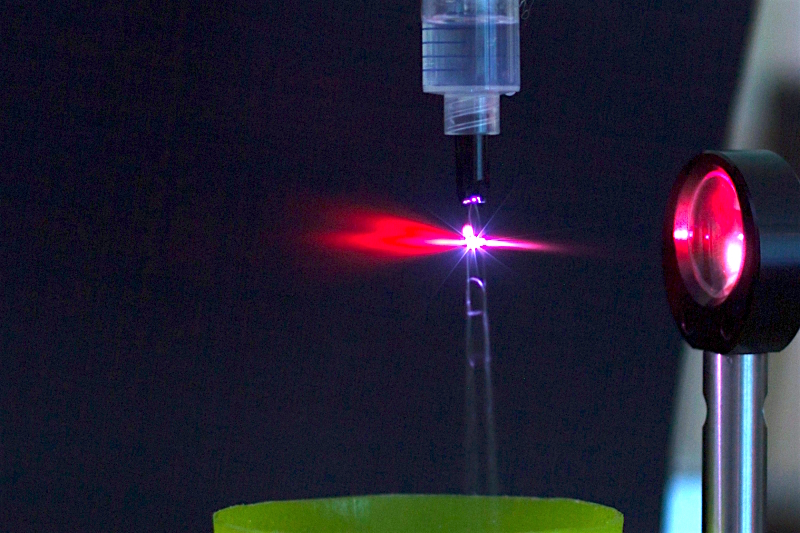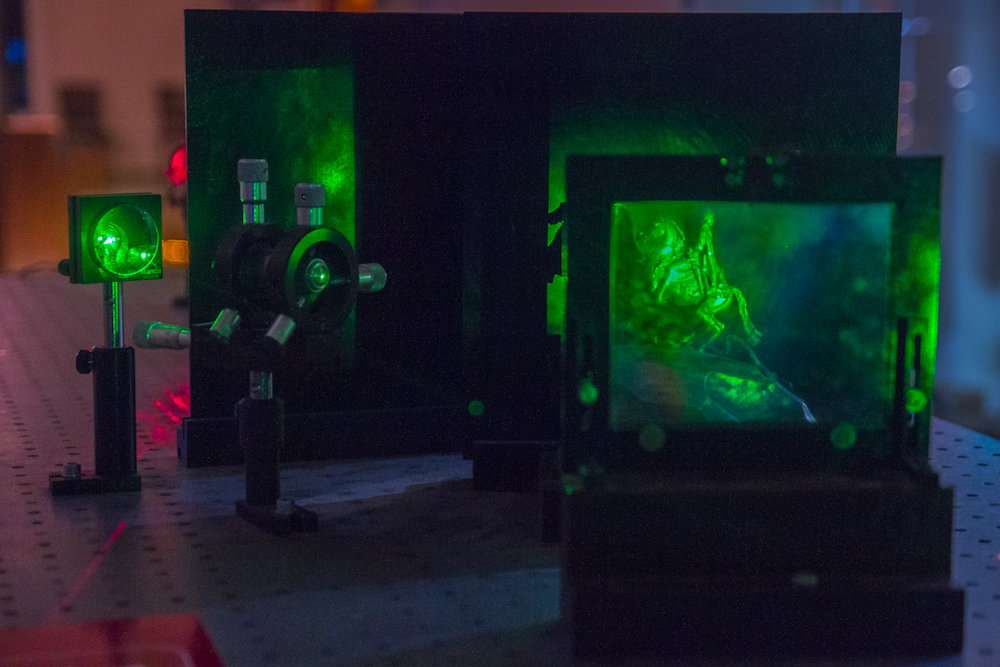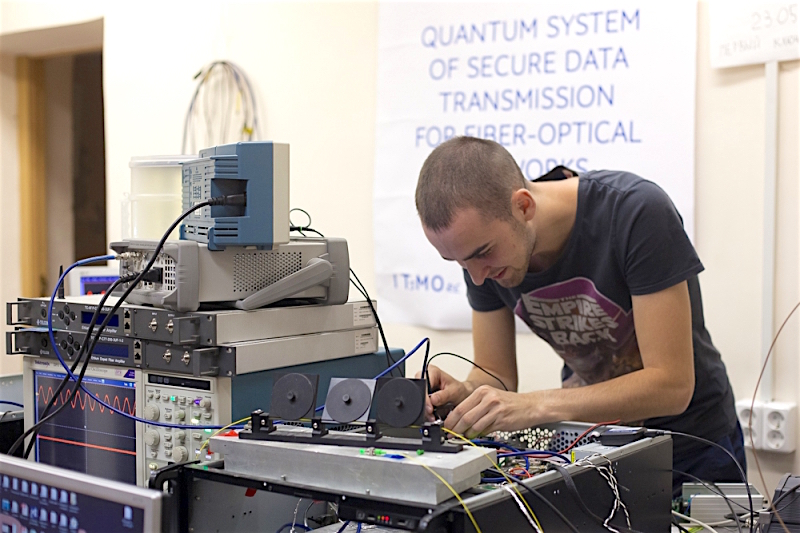From theory to practice: how undergraduates of the faculty of photonics and optoinformatics study and work
Master's program is a logical format for continuing studies at the university for those who have completed their undergraduate studies. However, it is not always clear to students where to go after graduation and, most importantly, how to move from theory to practice — to work and develop in their specialty - especially if this is not marketing or programming, but, for example, photonics.
We talked with the heads of laboratories of the International Institute of Photonics and Optoinformatics and graduates of the Faculty of Photonics and Optoinformatics to find out how to combine work and study, where you can get a job at the end of the university (or in the learning process), and what interests their future employers.

Photo by ITMO University
')
Undergraduates have the opportunity to try themselves in their chosen profession while still studying - and not tearing themselves between study and work. According to Anton Nikolayevich Tsypkin, head of the femtosecond optics and femtotechnology laboratory of the International Institute of Photonics and Optoinformatics, students begin with practical work in laboratories, and undergraduates continue to work at the institute.
Ksenia Volkova, who graduated from the ITMO University magistracy this year, told us how to work on the job. Ksenia notes that during the training she worked as an engineer in the laboratory of quantum informatics and participated in a university project:
Ksenia notes that while studying at the university, working “on the side” is, of course, more difficult - the schedule of couples may not always be convenient for combining. If you look for work within the walls of ITMO University itself, then there are much fewer problems with combining:

Photo by ITMO University
Another graduate of this faculty, Maxim Melnik, has similar experience. He graduated from the magistracy in 2015, in 2019 he defended his dissertation and combined work and study: “I have been working in the laboratory of femtosecond optics and femtotechnology since 2011, when I was in my third year of undergraduate studies. In the undergraduate and graduate programs I worked exclusively in science, starting from the first year of graduate school, administrative duties were added. ” As Maxim emphasizes, this approach only helps learning - this is how you can put into practice the skills that are acquired in the learning process: "Almost all of my classmates worked to one degree or another in the learning process in the magistracy."
Practicing while studying at the magistracy is possible not only in university structures, but also in companies that collaborate with the faculty of photonics and optoinformatics .
Another example of building a career in science is Yuri Kapoyko: “This is our graduate. He started as an engineer in the Scientific and Production Enterprise “Digital Radio Engineering Systems” and is now the head and chief designer of the Almanac multi-position aircraft surveillance system. This system has already been launched in Pulkovo, and they plan to introduce it at airports in other cities of Russia, ”says Olga Alekseevna Smolyanskaya, head of the femtomedicine laboratory of the International Institute of Photonics and Optoinformatics.

Photo by ITMO University
By the way, teachers also support the desire to combine work and study - moreover, they note that it is not necessary to be a graduate student for this:
According to graduates and teachers, employers especially appreciate the ability of employees to work with optical equipment and use software packages to calculate the optical properties of objects; resolution of the measuring system; for measuring system control, data processing and analysis. Employers also note the ability to use machine learning methods in their work.
Work in the specialty after graduation from the university is not the only scenario for the development of events for undergraduates. Some continue their scientific careers at the University - for example, Maxim Melnik did. He works as an engineer at the faculty of photonics and optoinformatics, is a deputy executive officer and is engaged in international cooperation of the International Institute of Photonics and Optoinformatics :

Photo by ITMO University
ITMO University laboratories are interested in students who want to pursue a career in science. Among them, for example, the Laboratory of Digital and Fine Holography :
Graduate students can build a career in science not only in their native university, but also abroad - in the scientific field ITMO University is well known. “A large number of acquaintances work in foreign universities or have joint international research grants,” says Maxim Melnik. Ksenia Volkova also decided to take this path - now she is entering graduate school in Switzerland.
As the experience of the faculty shows, in order to combine study and work, it is not necessary to sacrifice something - and after graduation, it is quite possible to get a job in a specialty, already having a profile work experience. This approach only helps in study, and the teachers and staff of ITMO University are ready to meet those who want to combine theory, practice and first steps in the profession.
We talked with the heads of laboratories of the International Institute of Photonics and Optoinformatics and graduates of the Faculty of Photonics and Optoinformatics to find out how to combine work and study, where you can get a job at the end of the university (or in the learning process), and what interests their future employers.

Photo by ITMO University
')
The first job in the specialty
Undergraduates have the opportunity to try themselves in their chosen profession while still studying - and not tearing themselves between study and work. According to Anton Nikolayevich Tsypkin, head of the femtosecond optics and femtotechnology laboratory of the International Institute of Photonics and Optoinformatics, students begin with practical work in laboratories, and undergraduates continue to work at the institute.
In our case, students work where they do their thesis. This helps them a lot in terms of preparing a master's thesis. The schedule is designed so that students spend about half a week studying. The rest of the time is spent on developing their research projects in companies or research groups.
- Anton Nikolaevich Tsypkin
Ksenia Volkova, who graduated from the ITMO University magistracy this year, told us how to work on the job. Ksenia notes that during the training she worked as an engineer in the laboratory of quantum informatics and participated in a university project:
Work was carried out on the project “ Creation of new technological components of geographically distributed data center management systems, including virtualization of resources (memory, communication lines, computing power, engineering infrastructure) using quantum technologies to protect communication lines ”.
In our laboratory, we were engaged in the study of quantum communication in the atmospheric communication channel. Specifically, my task was to study the spectral multiplexing of optical signals in one atmospheric communication channel. This study eventually became my final qualifying work, which I defended in June.
It is pleasant to realize that my research in the magistracy was not somehow abstract, but found application in the project (it is carried out by the University by order of SMARTS JSC).
- Ksenia Volkova
Ksenia notes that while studying at the university, working “on the side” is, of course, more difficult - the schedule of couples may not always be convenient for combining. If you look for work within the walls of ITMO University itself, then there are much fewer problems with combining:
At ITMO University, it is possible to study and work in parallel, especially if you managed to get into a scientific group that is working on some interesting project. About 30% of students combined work outside the university and study. If you take into account those who worked at ITMO University, the percentage is significantly higher.
- Ksenia Volkova

Photo by ITMO University
Another graduate of this faculty, Maxim Melnik, has similar experience. He graduated from the magistracy in 2015, in 2019 he defended his dissertation and combined work and study: “I have been working in the laboratory of femtosecond optics and femtotechnology since 2011, when I was in my third year of undergraduate studies. In the undergraduate and graduate programs I worked exclusively in science, starting from the first year of graduate school, administrative duties were added. ” As Maxim emphasizes, this approach only helps learning - this is how you can put into practice the skills that are acquired in the learning process: "Almost all of my classmates worked to one degree or another in the learning process in the magistracy."
Practice and work in companies
Practicing while studying at the magistracy is possible not only in university structures, but also in companies that collaborate with the faculty of photonics and optoinformatics .
I know for sure that several of my classmates had scientific supervisors from companies (for example, TYDEX, Peter-Service) and, accordingly, worked there or had practical training. After graduation, they remained to work there.
- Maxim Melnik
Interested in students and graduates of the faculty and other companies.
By the way, one of these - “ Quantum Communications ” - was discovered by ITMO University graduates. We repeatedly spoke about company projects on Habré .

Photo by ITMO University
- "Krylov State Scientific Center"
- "Center for preclinical and translational research" honey. center them. Almazova
- "Laser technology"
- Ural GOI
- "Proteus"
- Special Delivery
- "Quantum Communications"
By the way, one of these - “ Quantum Communications ” - was discovered by ITMO University graduates. We repeatedly spoke about company projects on Habré .

Photo by ITMO University
Another example of building a career in science is Yuri Kapoyko: “This is our graduate. He started as an engineer in the Scientific and Production Enterprise “Digital Radio Engineering Systems” and is now the head and chief designer of the Almanac multi-position aircraft surveillance system. This system has already been launched in Pulkovo, and they plan to introduce it at airports in other cities of Russia, ”says Olga Alekseevna Smolyanskaya, head of the femtomedicine laboratory of the International Institute of Photonics and Optoinformatics.

Photo by ITMO University
By the way, teachers also support the desire to combine work and study - moreover, they note that it is not necessary to be a graduate student for this:
Several of my students combine work and study. These were students working as programmers, engineers, or drawing technicians. For my part, I offered students graduation theses that corresponded to the profile of the company. The guys work in different training courses.
- Olga Alekseevna Smolyanskaya
According to graduates and teachers, employers especially appreciate the ability of employees to work with optical equipment and use software packages to calculate the optical properties of objects; resolution of the measuring system; for measuring system control, data processing and analysis. Employers also note the ability to use machine learning methods in their work.
The laboratory base of the university and the faculty of photonics and optoinformatics is impressive. Students, graduate students and employees have at their disposal optical and measuring equipment: from simple fiber components to complex high-frequency oscilloscopes and systems for recording ultra-weak single-photon light fields.
- Ksenia Volkova
PhD and scientific career
Work in the specialty after graduation from the university is not the only scenario for the development of events for undergraduates. Some continue their scientific careers at the University - for example, Maxim Melnik did. He works as an engineer at the faculty of photonics and optoinformatics, is a deputy executive officer and is engaged in international cooperation of the International Institute of Photonics and Optoinformatics :
In my work I am engaged in both science (in the fields of nonlinear optics, terahertz optics and ultrashort pulse optics), and the administration and supervision of projects.
I am the organizer of the annual international summer intensive research school in photonics “Research Summer Camp in Photonics” of ITMO University, and also I am a member of the organizing committee of the conference “Fundamental Problems of Optics” organized by ITMO University.
I participate as an executor in 4 grants, contests, FTPs held by the RFBR, RSF and other scientific organizations of the Ministry of Education of the Russian Federation.
- Maxim Melnik

Photo by ITMO University
ITMO University laboratories are interested in students who want to pursue a career in science. Among them, for example, the Laboratory of Digital and Fine Holography :
We do not focus on companies, in our laboratory we try to work with guys who decide to devote themselves to science. And sensible young people are now in great demand all over the world - both in the USA and in Europe. This spring, for example, our collaborator from Shenzhen (China) was looking for post-docs, with a salary of 230 thousand rubles. per month.
- Head of the Laboratory of Digital and Fine Holography ITMO University Nikolay Petrov
Graduate students can build a career in science not only in their native university, but also abroad - in the scientific field ITMO University is well known. “A large number of acquaintances work in foreign universities or have joint international research grants,” says Maxim Melnik. Ksenia Volkova also decided to take this path - now she is entering graduate school in Switzerland.
As the experience of the faculty shows, in order to combine study and work, it is not necessary to sacrifice something - and after graduation, it is quite possible to get a job in a specialty, already having a profile work experience. This approach only helps in study, and the teachers and staff of ITMO University are ready to meet those who want to combine theory, practice and first steps in the profession.
Now at the faculty of photonics and optoinformatics there are two master's programs:
Reception continues - you can submit documents until August 5 .
Source: https://habr.com/ru/post/461595/
All Articles